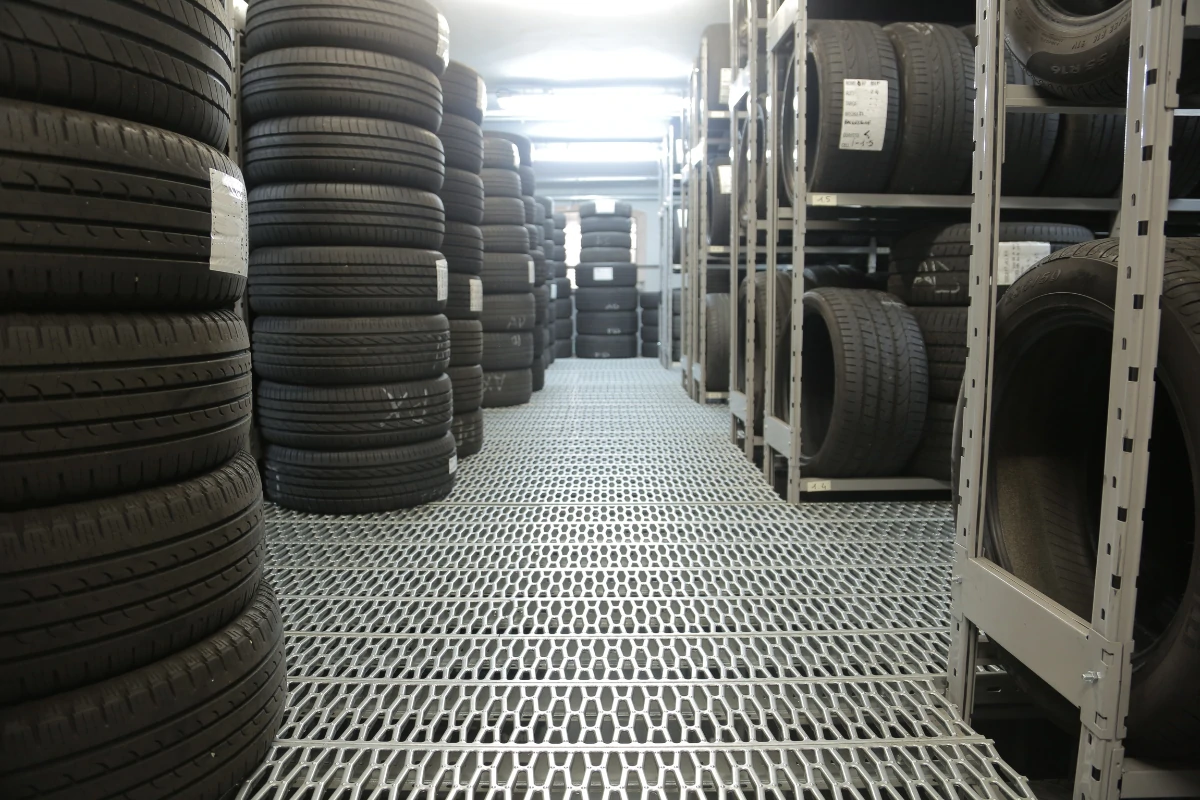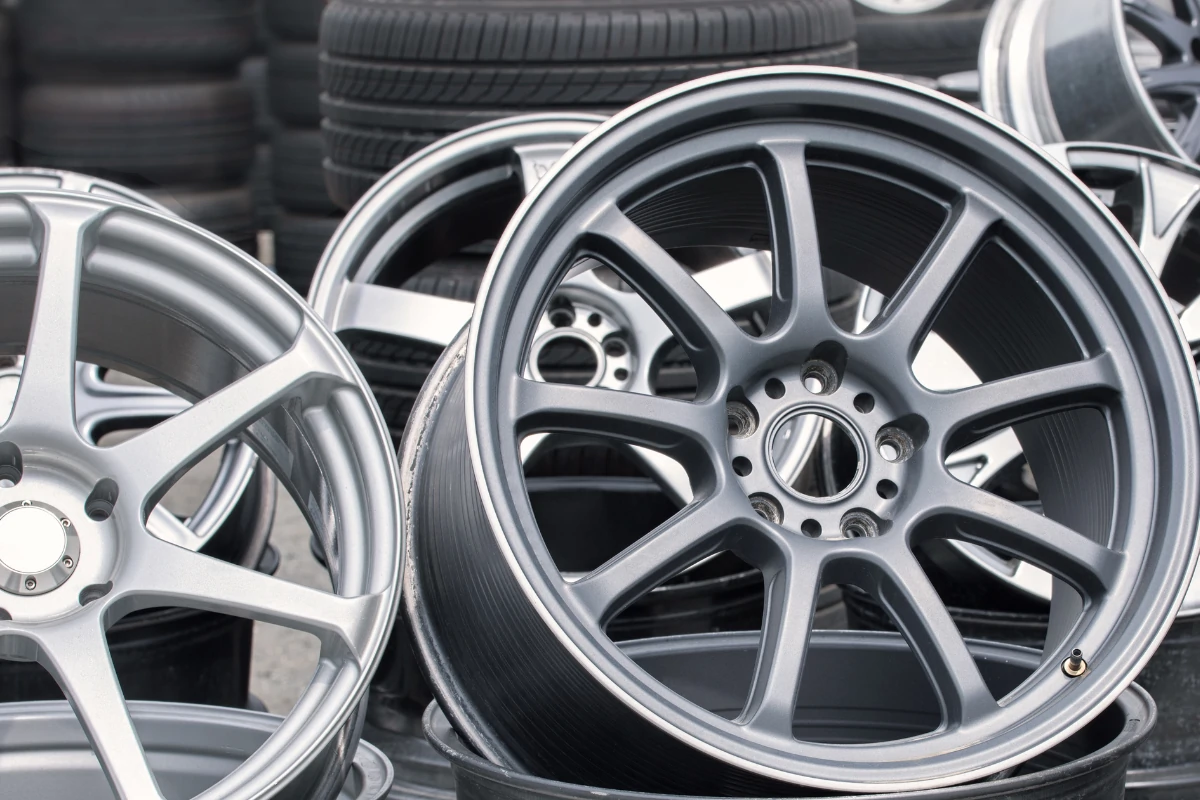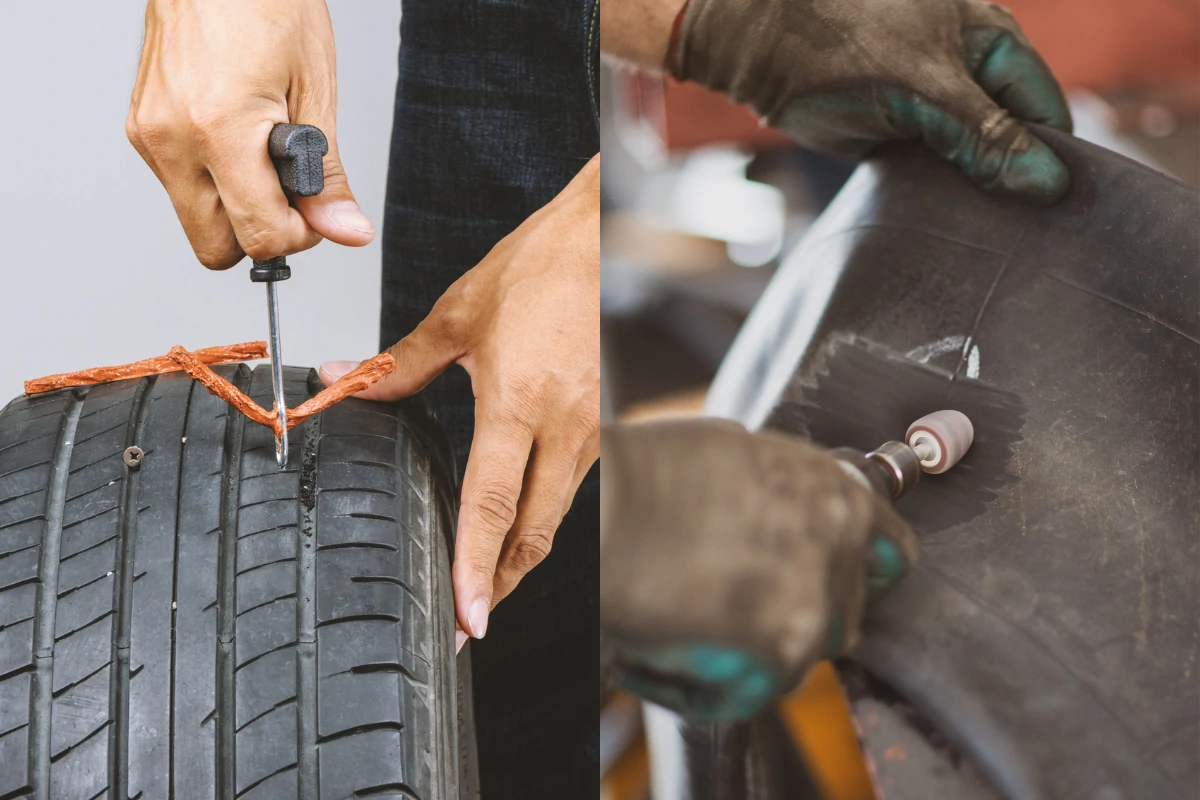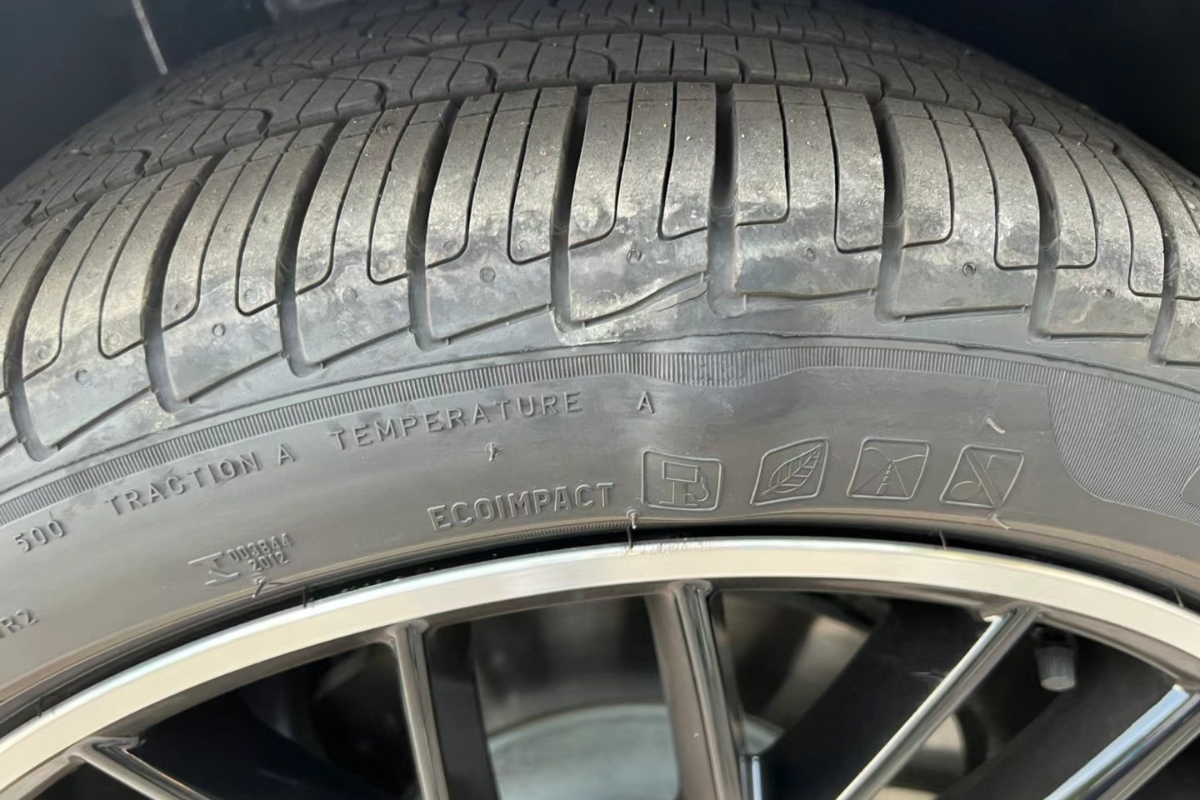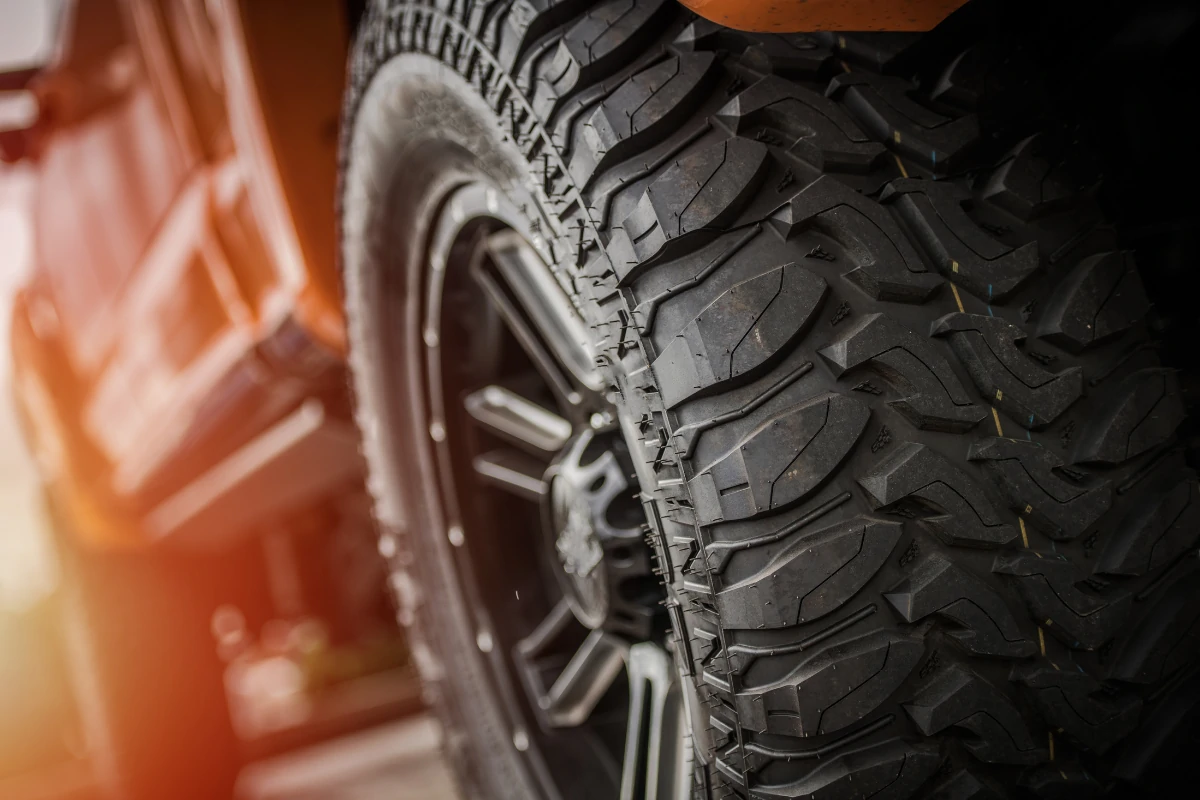Most people probably don’t think much about tires until they need to be replaced or repaired. But did you know that how you store tires can have a big impact on their lifespan, performance, and safety?
That’s what this guide is all about. I’ve worked as an engineer in the tire industry for 8 years. I know a thing or two about tires, and I’m here to share my knowledge and experience with you.
So, let’s dive in!
Table of Contents
Preparing Your Tires for Storage
Before storing tires, you need to prepare them properly. This will help you preserve their quality and condition. And it will be easier for you to retrieve and reinstall them when needed.
Cleaning and Inspection
Before you even think about storing your tires, cleaning, and inspection are crucial steps.
Cleaning removes dirt, debris, and contaminants that can cause tire deterioration. I recommend using a mild soap and water solution. Dry your tires with a cloth or towel, making sure there is NO moisture left on the surface.
Remember to check for any visible damage or punctures. A thorough inspection can save you headaches later.
Storing on Rims vs. Off-Rims
Should you store your tires on rims or remove them before storage? The answer depends on your specific situation.
Storing tires on rims can help maintain their shape and simplify the installation process. But it’s not always the best choice. For instance, if you have limited storage space, removing the tires from the rims can be more practical. Assessing your needs and the available space before making this decision.
Tire Pressure Adjustment
Once you make the decision to store tires on rims, you should consider adjusting tire pressure. This step is often overlooked, but it’s critical.
Low tire pressure can lead to flat spots and structural damage over time. Consult your vehicle’s manual or the tire manufacturer’s recommendations for the correct pressure level.
It’s a simple yet effective way to ensure your tires remain in good shape.
Choosing the Right Storage Location
The right location will help you protect your tires from the elements and prevent any damage or deformation.
The ideal location for tire storage should be:
Cool: The temperature should be between 10°C and 25°C, and not fluctuate too much. High temperatures can accelerate tire aging and dry rot. While low temperatures can make the rubber stiff and brittle.
Dry: The humidity should be between 40% and 80%, and not vary too much. High humidity can cause mold and mildew. While low humidity can dry out the rubber and cause cracks.
Dark: The light should be dim or absent. Avoid exposing the tires to direct sunlight or artificial sources. Sunlight can cause fading and discoloration. And artificial light can emit ozone and UV rays that can degrade the rubber.
Clean: The environment should be free of dust, dirt, grease, or chemicals that can stain or corrode the rubber. It should also be free of rodents, insects, or other pests that can chew or damage the tires.
Based on these criteria, some of the possible locations for tire storage are:
Garage
A garage is a common and convenient place to store your tires. And it is usually close to your vehicle and easy to access. If you choose to store your tires in your garage, make sure to:
- Insulate your garage to prevent extreme heat or cold.
- Ventilate your garage to prevent moisture buildup or mold growth.
- Cover your windows or use curtains to block sunlight or artificial light.
- Sweep your floor and remove any oil spills or chemical leaks.
Basement
A basement is another option to store your tires, as it is usually cool, dry, dark, and clean. If you choose to store your tires in your basement, make sure to:
- Measure your space and plan your layout to avoid clutter or obstruction.
- Install a dehumidifier or a fan to control the humidity and air circulation.
- Use a light switch or a timer to limit the exposure to artificial light.
- Seal any cracks or holes to prevent dust, dirt, or pests from entering.
Shed
A shed is another option to store your tires, as it is usually separate from your house and easy to organize. If you choose to store your tires in your shed, make sure to:
- Reinforce your shed to withstand weather conditions and temperature changes.
- Install a heater or a cooler to regulate the temperature and prevent freezing or overheating.
- Use a tarp or a blanket to cover your tires and protect them from sunlight or rain.
- Clean your shed and remove any debris or flammable materials.
The Method of Tire Storage
The method of your tire storage can be horizontal or vertical. It should depend on the shape and size of your tires and the available space and equipment.
The ideal method for tire storage should be:
Stable: The tires should be supported by a solid and flat surface that can bear their weight and prevent them from rolling or falling. The tires should also be balanced and aligned to avoid any stress or strain on the rubber or the rim.
Spacious: The tires should have enough space around them. This allows air circulation and prevents any contact or friction with other objects or surfaces. The tires should also be spaced apart from each other to avoid any pressure or deformation.
Protective: The tires should be covered or wrapped with a material that can shield them from dust, dirt, moisture, light, or ozone. The material should also be breathable and non-abrasive to prevent any condensation or damage to the rubber.
Based on these criteria, some of the possible methods for tire storage are:
Standing Up

Storing tires vertically, standing up, means they are placed with the tread touching the ground and the sidewalls facing outwards.
This is the best option for tires without rims. It puts the least stress on your tires. And it also makes it easy to inspect tires for damage and tread wear.
- You can simply place your tires upright on the floor, or on a shelf or a rack.
- Make sure there is some space between them, and do not stack anything on top of them.
- Cover your tires with a tire bag or a plastic sheet to protect them from dust, dirt, light, or ozone.
Stacking

Stacking tires involves placing one on top of another, like a tower. You can use a tire rack or a sturdy surface to stack them safely.
This is a good option for tires with rims, if you have limited space. But it can put some pressure on your tires.
- You can stack your tires on their sides, either on the pallet or a platform.
- Stack your tires no more than four high and rotate them monthly to distribute the load evenly.
- Stack them with the wheel face down to protect the valve stem.
- Wrap your tires with a tire bag or a plastic sheet.
Hanging

Hanging tires involves suspending them from a wall or ceiling using tire hooks or racks. This method keeps tires off the ground.
This is another good option for tires with rims, but it requires some hardware.
- You can hang your tires on hooks or racks, either on the wall or on the ceiling.
- Make sure the hooks or racks are strong enough to support the weight of your tires.
- Hang them with the wheel face out to protect the valve stem.
- Wrap your tires with a tire bag or a plastic sheet.
The Do’s and Don’ts of Tire Storage
The Do’s
To ensure proper tire storage, follow these key practices:
- Keep tires clean and dry.
- Regular inspections.
- Rotate your tires every 6 months if stored for an extended period.
- Use tire storage bags or covers to protect from environmental factors.
- Maintain recommended tire pressure levels.
The Don’ts
Common mistakes in tire storage include:
- Storing tires near heat sources or chemicals.
- Allowing tires to come into contact with concrete floors.
- Overloading racks or stacking tires haphazardly.
- Exposing tires to direct sunlight or extreme temperatures.
Why You Need to Store Tires Correctly

You may think that tires are just rubber and air, and that they can withstand any kind of storage condition.
But that’s not true. Tires are complex engineering products that are affected by various factors.
Temperature, humidity, sunlight, ozone, and pressure.
These factors can cause tire aging and deterioration and finally lead to various problems, such as:
Cracks: Cracks are small fissures that appear on the surface or inside the rubber. They can be caused by exposure to heat, sunlight, ozone, or low pressure. Cracks can weaken the rubber and make it more prone to blowouts or leaks.
Dry rot: Dry rot is the decay of the rubber due to the loss of essential oils and antioxidants. It can be caused by exposure to high temperatures, low humidity, or chemicals. Dry rot can make the rubber brittle and crumbly and reduce its flexibility and grip.
Flat spots: Flat spots are areas of the tire that become flattened due to prolonged contact with the ground. They can be caused by storing the tires under load, without rotation, or with low pressure. Flat spots can affect the balance and alignment of the tire, and cause vibrations and noise.
FAQ
Should tires be stored flat or upright?
The answer depends on whether you’re storing tires with or without rims.
If you’re storing tires without rims, it’s best to keep them upright. This helps maintain their shape and integrity over time.
On the other hand, if you’re dealing with tires that have rims, you can stack them or hang them. This can help protect the valve stem and the wheel face.
Of course, other factors come into play, such as available space, tire weight, and the necessary hardware. For more detailed information, you can refer to the post I’ve written.
Is it OK to store tires on top of each other?
The answer is yes, when you:
- Store tires with rims.
- Stack your tires on their sides, either on the pallet or a platform.
- Stack your tires no more than four high and rotate them every month to distribute the load evenly.
- Stack them with the wheel face down to protect the valve stem.
- Wrap your tires with a tire bag or a plastic sheet.
How do you store tires properly?
There are different ways to store tires properly, depending on whether they are mounted or unmounted, and how much space you have. Here are some general tips for tire storage:
- Clean and dry the tires thoroughly before storing them.
- Keep the tires out of the sun, heat, ozone, or chemicals.
- Store the tires in a cool, dry, indoor environment, such as a garage or a storage unit.
- If the tires are unmounted, store them upright, leaning next to each other horizontally. Do not hang unmounted tires on hooks or racks, as this could cause them to sag.
- If the tires are mounted, you can either hang them on hooks or racks, or stack them on their sides. If you stack them, do not stack them too high, and place a piece of wood between each tire to prevent flat spots. Rotate the tires every month to prevent deformities.
- Remove the tires from vehicles that you are storing for a long time, and put them in airtight plastic bags.
Conclusion
We hope you found this post helpful and learned some useful tips on tire storage.
By following these tips, you can extend the life of your tires, save money, and avoid potential hazards.
Remember to always check your tires before and after storage. And consult a professional if you have any doubts or questions.
Thank you for reading, and happy driving!

